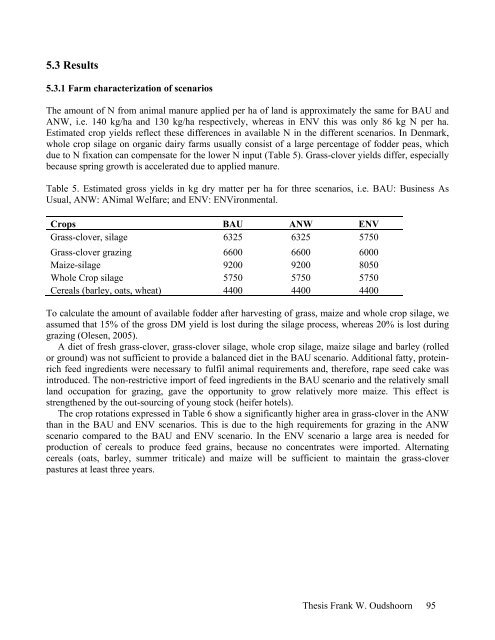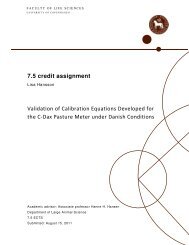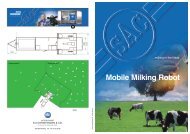Innovative Technology and Sustainable Development of Organic - 1.
Innovative Technology and Sustainable Development of Organic - 1.
Innovative Technology and Sustainable Development of Organic - 1.
You also want an ePaper? Increase the reach of your titles
YUMPU automatically turns print PDFs into web optimized ePapers that Google loves.
5.3 Results<br />
5.3.1 Farm characterization <strong>of</strong> scenarios<br />
The amount <strong>of</strong> N from animal manure applied per ha <strong>of</strong> l<strong>and</strong> is approximately the same for BAU <strong>and</strong><br />
ANW, i.e. 140 kg/ha <strong>and</strong> 130 kg/ha respectively, whereas in ENV this was only 86 kg N per ha.<br />
Estimated crop yields reflect these differences in available N in the different scenarios. In Denmark,<br />
whole crop silage on organic dairy farms usually consist <strong>of</strong> a large percentage <strong>of</strong> fodder peas, which<br />
due to N fixation can compensate for the lower N input (Table 5). Grass-clover yields differ, especially<br />
because spring growth is accelerated due to applied manure.<br />
Table 5. Estimated gross yields in kg dry matter per ha for three scenarios, i.e. BAU: Business As<br />
Usual, ANW: ANimal Welfare; <strong>and</strong> ENV: ENVironmental.<br />
Crops BAU ANW ENV<br />
Grass-clover, silage 6325 6325 5750<br />
Grass-clover grazing 6600 6600 6000<br />
Maize-silage 9200 9200 8050<br />
Whole Crop silage 5750 5750 5750<br />
Cereals (barley, oats, wheat) 4400 4400 4400<br />
To calculate the amount <strong>of</strong> available fodder after harvesting <strong>of</strong> grass, maize <strong>and</strong> whole crop silage, we<br />
assumed that 15% <strong>of</strong> the gross DM yield is lost during the silage process, whereas 20% is lost during<br />
grazing (Olesen, 2005).<br />
A diet <strong>of</strong> fresh grass-clover, grass-clover silage, whole crop silage, maize silage <strong>and</strong> barley (rolled<br />
or ground) was not sufficient to provide a balanced diet in the BAU scenario. Additional fatty, proteinrich<br />
feed ingredients were necessary to fulfil animal requirements <strong>and</strong>, therefore, rape seed cake was<br />
introduced. The non-restrictive import <strong>of</strong> feed ingredients in the BAU scenario <strong>and</strong> the relatively small<br />
l<strong>and</strong> occupation for grazing, gave the opportunity to grow relatively more maize. This effect is<br />
strengthened by the out-sourcing <strong>of</strong> young stock (heifer hotels).<br />
The crop rotations expressed in Table 6 show a significantly higher area in grass-clover in the ANW<br />
than in the BAU <strong>and</strong> ENV scenarios. This is due to the high requirements for grazing in the ANW<br />
scenario compared to the BAU <strong>and</strong> ENV scenario. In the ENV scenario a large area is needed for<br />
production <strong>of</strong> cereals to produce feed grains, because no concentrates were imported. Alternating<br />
cereals (oats, barley, summer triticale) <strong>and</strong> maize will be sufficient to maintain the grass-clover<br />
pastures at least three years.<br />
Thesis Frank W. Oudshoorn 95




